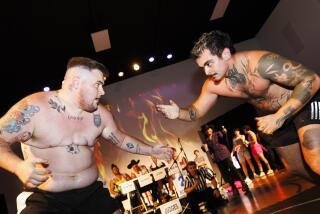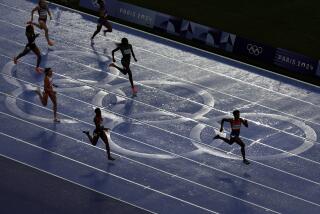U.S. OLYMPIC FESTIVAL : LOS ANGELES 1991 : Walking a Thin Line : Cutting weight: Young athletes risk long-term harm to their health by rapidly dropping pounds.
Sibby Flowers could lift the weight, she simply could not make it.
An hour before her designated weigh-in period ended at the 1989 Olympic Festival weightlifting competition, Flowers was half a pound too heavy. This, after spending five hours in a sauna squeezing every ounce of water from her muscled body.
The sauna was across town, she recalled this week, and she had to scurry back to try to shed eight more ounces so she could compete in the 97-pound category. She returned with two minutes before her weigh-in deadline and made weight.
“Then I got sick,” she said.
Coaches tried to rejuvenate her with bananas and water.
“My stomach was all torn up,” said Flowers, who nonetheless won the competition.
She said the ordeal left her too weak to compete, but years of lifting carried her to victory. “They call it muscle memory. It just came back.”
Flowers, from Carrollton, Ga., hardly sounded like a champion when recalling the misery of her victorious moment. She missed the opening introductions because she was in a restroom trying to regain her composure. She was cramping badly before her lift, so coaches pinned her against a wall to straighten her arms and forearms. Still, when she gripped the bar on the platform, her hands cramped so tightly that she needed assistance to let go.
“I had to pull my hand off the bar so I could leave the stage,” she said. “I had diarrhea and had to run back and forth to the bathroom between my clean and jerks, and snatches.”
Flowers, who is competing at UCLA this week during the Festival’s weightlifting competition, is not the only one who has suffered from rapid weight loss. Boxers, weightlifters and wrestlers often are measured by more than punches, snatches and takedowns.
For them, how much they weigh determines whether they will compete. To win, they think thin.
But cutting weight is one of the shadowy issues of sport, almost to the point of being a cult-like rite of passage. Exercise physiologists who spend their lives measuring body composition said the dieting practices they have observed are unhealthy.
The American Medical Assn. and the American College of Sports Medicine have admonished athletes about weight cutting for years. But warnings have gone unheeded because these sports are steeped in tradition that has accepted rapid weight loss as part of the game.
Flowers, 27, said she learned a valuable lesson two years ago when she tried to return to weightlifting two months after giving birth to her son, Christopher. She said she was about 60 pounds overweight because of the pregnancy and tried to drop it in time to compete in the 1989 national championships.
“I just went nuts when I got pregnant because I had to watch my weight for so long,” said Flowers, a 4-foot-10 3/4 lifter.
She did not consider Ultra Slim-Fast, Nutri/System, Jenny Craig or the Cambridge, Beverly Hills or Pritikin diet plans. She had a more sure-fire method: She did not eat for two or three weeks.
She said her coach also had some advice. “He got me in there to try to throw up; I had to spit in a cup and I had to try to make myself throw up.”
Flowers, however, said she does not have an eating disorder. She attributes her situation to reckless abandon during pregnancy. Now she is fine, she said, except for her craving for cupcakes and brownies after competitions.
Yet Flowers is one of the legions who have perhaps been on the edge without realizing it.
The long-term effects of bingeing and purging in youngsters is not clearly understood, said Timothy Lohman of the Department of Exercise and Sports Sciences at the University of Arizona. Lohman, whose specialty is growth and development, said he is concerned about the health of those who believe there is no harm in drastic weight changes.
Lohman suspects that the starvation and dehydration scenario practiced year after year by athletes will repress normal growth patterns. Although documenting his theory would be difficult, Lohman said: “Kids are practicing things that go against their strength and health. It doesn’t make sense. I have a real question (concerning) what these kids will be like in their 40s. What’s going to happen to them?”
Medical data is limited. Even anecdotal evidence is not readily available. But experts say such dieting practices could result in kidney disorders, heart irregularities and perhaps the least publicized of diseases, eating disorders in young males.
Robert Oppliger, coordinator for special projects of the State Health Registry at the University of Iowa’s College of Medicine, has surveyed high school wrestlers in Iowa and Wisconsin.
He was most startled by responses indicating that 2% of the teen-age boys had eating disorders. He said that percentage was much higher than suspected.
Although a survey is not documented medical data, Oppliger said the information is worth researching.
He said the wrestlers’ eating habits could represent a problem, one that has not been considered because of the emphasis on women’s disorders. Experts believe that almost 95% of anorexia, or self-starvation, cases involve women.
But they are starting to focus on male athletes who suffer from bulimia, or induced vomiting. Athletes might use vomiting almost as protocol to make weight. But some begin to identify with being thin.
“That is where the ego is satisfied,” Oppliger said. “It’s not that hard to slip over the edge.”
In Wisconsin, doctors hope that they have a solution to block the path to bulimia. Each high school wrestler is weighed before the season to determine body fat. Based on the result, each wrestler is assigned a minimum weight classification. Boys are not allowed to wrestle below their designated category and, so the theory goes, thus will not try to diet to the point of starvation.
Arizona’s Lohman said experts have established a 5% body fat level as being the absolute minimum. After that, he said, the subject begins to lose lean tissue rather than weight.
Wisconsin might be on the threshold of a major breakthrough, but until its system becomes universally accepted, the dreaded diet will remain entrenched in sports that have weight classifications.
“There’s nothing funny about losing weight,” said John Herrera, a 112-pound flyweight boxer from Corpus Christi, Tex.
Herrera, 22, knows this as well as anyone.
“He’s the king of losing weight; I’ve never seen anyone lose it like he does,” said Edward Escobedo, a super-heavyweight from McKinney, near Dallas.
Herrera, who was disqualified for holding in the third round after being knocked down twice by Tim Austin in the title fight Tuesday, weighed 130 pounds three weeks ago. A painter’s assistant at a Texas oil refinery, Herrera was highly motivated to shed the pounds to compete in Los Angeles. He could not go to the Goodwill Games last year because he failed to make weight at 106 pounds. “I couldn’t even break 110,” he said. “They told me I had no body fat.”
Herrera, who switched to the 112-pound category, simply does not eat before competitions. Sunday at Loyola Marymount, Herrera said he needed to drop two pounds to box the next day.
“I’ll just sweat it out,” he said, adding that the loss will not affect his strength and stamina in the ring. Herrera has plied the tricks of weight loss since he was a 12-year-old competitor. “Without willpower, I wouldn’t be here right now,” he said. Or without a plastic sweat suit, a warm-up, the ability to run every day, Vaseline and a cosmetic product that removes makeup and opens pores to induce sweating.
Escobedo, who became a super-heavyweight when he realized it was too difficult to diet all the time, said other competitors use laxatives and other agents to flush their systems.
Kenneth Friday, a 125-pound boxer from Offutt Air Force Base in Nebraska, recalled the time a fellow boxer was given an enema at the arena where the fight was scheduled. “It worked,” Friday said. “He made weight and fought.”
Michael Pasdo, a 149-pound wrestler from Marquette, said he and his buddies once went dancing while wearing plastic body suits to help them lose weight.
Narvin Viravong, a 105-pound wrestler from the University of Oklahoma, said sex is another “fun” way to drop weight.
When Herrera gets desperate, he shaves his head and cuts his nails.
Some methods are no longer legal, such as taking water pills, diuretics and amphetamine diet pills.
“It was no good, but that was what they were doing,” Escobedo said of the drugs. “I was doing that when I was 12 and 13.”
Whatever formula athletes use, few realize the hazards of dehydration. Robert Voy, formerly the chief medical officer of the U.S. Olympic Committee, recalled the medical staff’s concern for U.S. boxers during the Seoul Olympic Games in 1988.
Voy, who has a private practice in Las Vegas, said doctors closely monitored the progress of the boxers who needed to drop weight quickly during the intense competition. Voy said they were able to determine who would lose their bouts because of their weakened state from the weight loss.
Dehydration causes a loss of minerals such as potassium and magnesium and saps athletes of endurance and power. Although the competitors replenish their body fluids shortly after weighing in, they are not in the shape they think.
“I doubt it for many of them,” Lohman said.
Voy said he emphasizes to coaches that teen-agers should be allowed to advance in weight classifications as they grow. Some coaches, however, encourage their athletes to compete at a lower level because they believe the chances for success increase.
“They don’t realize they are doing a disservice,” Voy said.
Lyn Jones, national coaching director for the U.S. Weightlifting Federation, said determining how far to allow an athlete to reduce depends on the individual. He checks the progress of all his lifters to ensure they are not going too far.
Jones endorses dehydration through saunas. His main concern before the Festival weightlifting competition was arranging for a sauna near UCLA. He said they are not always available at multisport competitions.
Herrera, the 112-pound boxer, said he prefers to run off his weight because saunas make him weak. But Jones said running expends too much energy, adding: “If we tried running, we’d kill our lifters,” he said.
Jones said there is a science to using the sauna. Athletes who hit the sweat box the day before competition are weakened; those who use it shortly before their weigh-in perform well, he said.
Another tried-and-true method, Jones said, is wrapping an athlete in a plastic garbage bag, adding a warm-up suit, and wishing him or her a good night’s sleep. Herrera said he naturally loses a pound during the night.
Jones added that dehydration is not a problem as it is in boxing or wrestling because lifters compete for such a short duration. Still, problems such as Sibby Flowers’ occur.
At the 1989 Festival, Tony McRae had to be carried off the platform because of cramps after his first lift. He was given Gatorade and returned to finish the competition no worse for the wear, weightlifting officials said.
These athletes are young and have their strength. They recuperate quickly. But what happens when they retire?
Flowers, who once was a gymnastics coach, said her family tends to be heavy. So, she plans to train at a low level to maintain her weight after her career ends.
Herrera has no such illusions. “I’ll probably get fat for sure,” he said.
More to Read
Go beyond the scoreboard
Get the latest on L.A.'s teams in the daily Sports Report newsletter.
You may occasionally receive promotional content from the Los Angeles Times.






